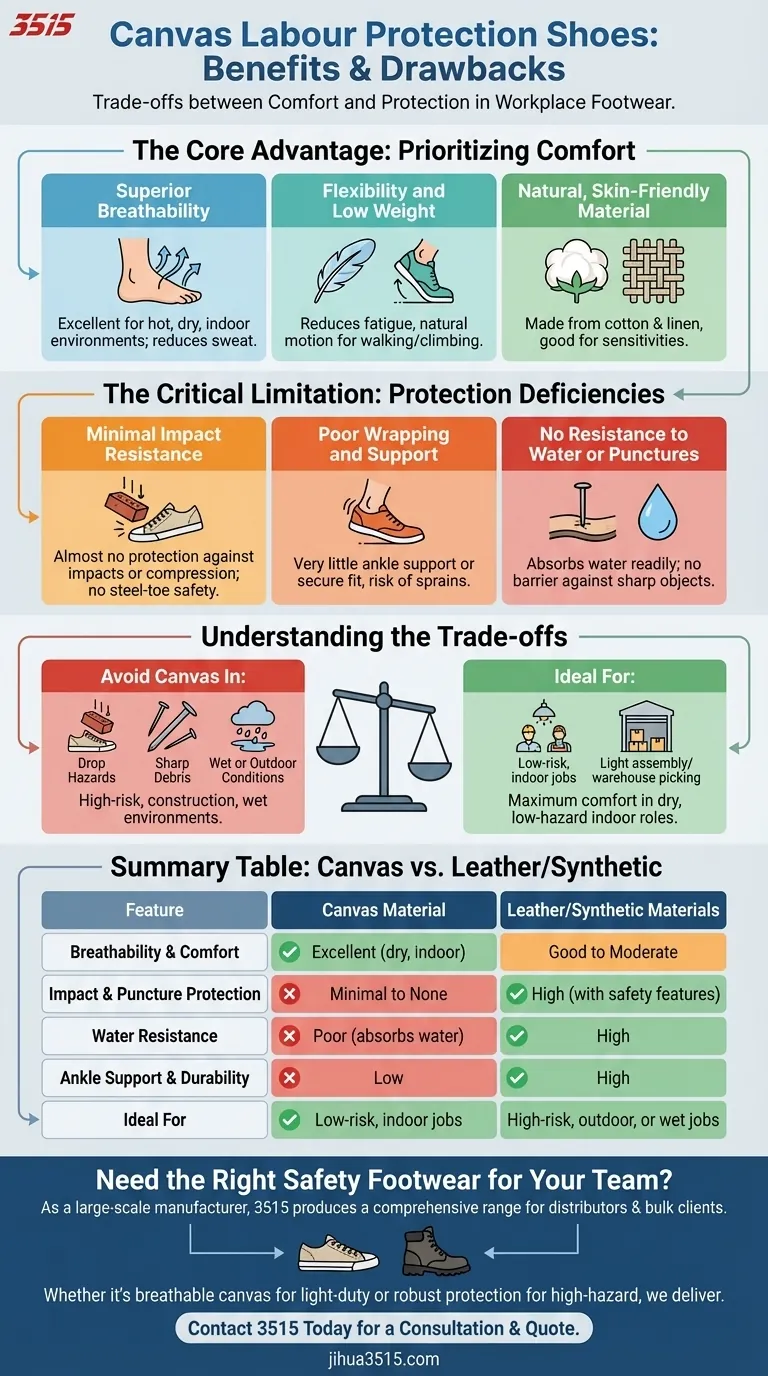In short, canvas is an excellent material for labor protection shoes when the primary needs are breathability and comfort in a low-hazard environment. Its main drawbacks are a significant lack of protection against impact, punctures, and moisture, making it unsuitable for more dangerous or wet workplaces.
The decision to use canvas in a work shoe is a direct trade-off: you are prioritizing comfort and airflow over the robust protection offered by materials like leather or synthetics. This makes canvas a specialized choice, not a general-purpose one.

The Core Advantage: Prioritizing Comfort
Canvas, a coarse fabric woven from cotton or linen, offers a distinct set of benefits centered entirely around wearer comfort, especially in specific conditions.
Superior Breathability
Canvas is inherently porous, allowing air to circulate freely around the foot. This makes it an ideal choice for hot, dry, indoor environments, significantly reducing sweat and discomfort during long shifts.
Flexibility and Low Weight
Unlike rigid leather or heavy synthetic composites, canvas is lightweight and flexible. This reduces foot fatigue and allows for a more natural range of motion, which is beneficial for jobs requiring constant walking or climbing.
Natural, Skin-Friendly Material
As a fabric made from cotton and linen, canvas is a healthy and generally non-irritating material. This can be an important factor for individuals with sensitivities to synthetic materials or chemicals used in tanning leather.
The Critical Limitation: Protection Deficiencies
While comfortable, the properties that make canvas breathable and flexible also make it a poor choice for genuine hazard protection.
Minimal Impact Resistance
Canvas fabric offers almost no protection against impacts from falling objects or compression from heavy machinery. It cannot provide the structural safety found in steel-toe or composite-toe boots.
Poor Wrapping and Support
The material's flexibility means it offers very little in the way of ankle support or a secure "wrap" around the foot. This can increase the risk of sprains and instability on uneven surfaces.
No Resistance to Water or Punctures
Canvas readily absorbs water, making it completely unsuitable for wet or damp conditions. Furthermore, the woven fabric provides no meaningful barrier against sharp objects like nails, glass, or metal shavings.
Understanding the Trade-offs: When to Avoid Canvas
Choosing the wrong material for your environment can compromise your safety. Canvas is the wrong choice in any situation with moderate to high risk.
Environments with Drop Hazards
If you work in construction, a warehouse with heavy stock, or any job with a risk of falling objects, canvas shoes are not a safe option. They lack the fundamental reinforcement needed to protect against crush injuries.
Workplaces with Sharp Debris
For jobs in demolition, waste management, or sites with frequent metalwork, canvas offers no protection from underfoot punctures. A certified puncture-resistant sole plate is essential, and these are rarely paired with a canvas upper.
Wet or Outdoor Conditions
Due to its high absorbency, canvas is unsuitable for outdoor work, food processing, or any environment where liquids are present. Wet feet can lead to significant health and comfort issues, and canvas offers no barrier.
Making the Right Choice for Your Goal
Your specific work environment must dictate your choice of footwear material.
- If your primary focus is maximum comfort in a dry, low-risk indoor job (like light assembly or warehouse picking): Canvas is a strong and logical choice for all-day wear.
- If your primary focus is protection from impact, punctures, or wet conditions (like construction, manufacturing, or outdoor labor): You must avoid canvas and select a boot made from leather or advanced synthetic materials.
Ultimately, understanding the clear line between canvas's comfort and its protective failures is the key to making a safe and effective choice.
Summary Table:
| Feature | Canvas Material | Leather / Synthetic Materials |
|---|---|---|
| Breathability & Comfort | Excellent for dry, indoor environments | Good to Moderate |
| Impact & Puncture Protection | Minimal to None | High (with safety toes and plates) |
| Water Resistance | Poor (absorbs water) | High |
| Ankle Support & Durability | Low | High |
| Ideal For | Low-risk, indoor jobs (e.g., light assembly) | High-risk, outdoor, or wet jobs (e.g., construction) |
Need the Right Safety Footwear for Your Team?
As a large-scale manufacturer, 3515 produces a comprehensive range of footwear for distributors, brand owners, and bulk clients. Whether your workforce needs the breathable comfort of canvas for light-duty roles or the robust protection of leather and synthetics for high-hazard environments, we have the production capabilities and expertise to deliver.
Let us help you equip your team with safe, comfortable, and durable footwear tailored to your specific workplace hazards.
Contact 3515 today for a consultation to discuss your requirements and get a quote.
Visual Guide

Related Products
- Safety Footwear Wholesale Manufacturer for Custom OEM/ODM Production
- Durable High-Traction Canvas Sneakers Wholesale & Custom Manufacturing
- Custom OEM Training Shoes Wholesale Manufacturer Durable & Breathable
- Advanced KPU Athletic Safety Shoe with Steel Toe Cap Anti-Slip Rotary Lacing System
- Wholesale Safety Footwear Manufacturer for Bulk & Custom OEM Orders
People Also Ask
- What are OSHA approved shoes? Understanding the Correct Standards for Workplace Safety
- Do snake bite boots work? Your Ultimate Guide to Effective Snake Bite Protection
- What are the cultural perspectives on wearing shoes in the house? A Guide to Home Etiquette & Hygiene
- What cultural and environmental considerations are tied to wearing shoes indoors? Balance Hygiene, Tradition, and Foot Health
- How do safety shoes contribute to cost savings for companies? A Strategic Investment in Risk and Cost Management



















